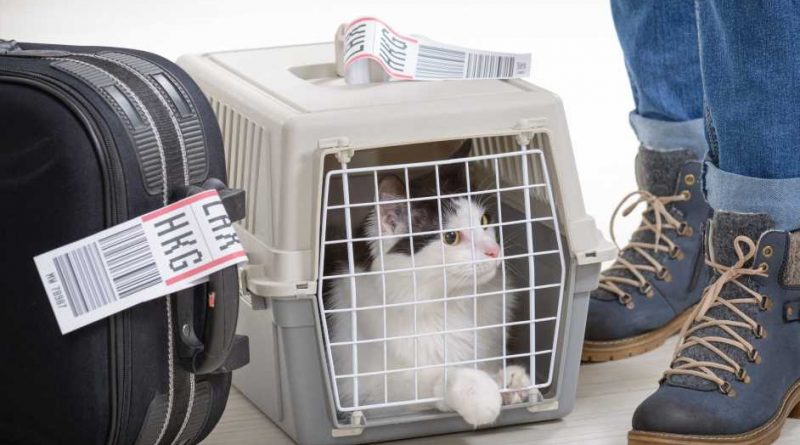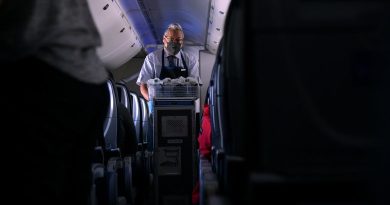5 best tips to keep your cat calm during a flight, according to veterinarians
- When flying with a cat, it’s important to get your cat comfortable with a carrier before the flight.
- You should also pack a harness, training pads, a water dish, and cat food.
- You can try natural calming aids like pheromones or prescription sedatives for the flight.
- Visit Insider’s Health Reference library for more advice.
Flying with your cat can seem intimidating – it’s hard to predict exactly how your cat will react to the airport and plane ride.
But preparing beforehand by testing out calming supplements and getting your cat comfortable with a carrier can help ease the process.
Here are several methods you can use to get your cat ready to fly and make the experience as smooth as possible.
1. Get your cat comfortable with a cat carrier
Your cat will need to spend the entire flight inside a carrier, so it’s important to train your cat to feel comfortable with it.
Types of plane-safe cat carriers
There are two main types of carriers you can bring on a plane:
- Soft carriers are made from flexible materials and often have mesh sides for ventilation. You can transport soft carriers with a shoulder strap or get a rolling carrier that you can pull like a suitcase.
- Hard carriers are made from more sturdy plastic. Most hard carriers can be taken apart so that the top and sides can be lifted off of the bottom piece.
Here’s how to get your cat used to a carrier:
Load Error
- If you’re using a hard carrier, you can leave just the bottom part in one of your cat’s favorite spots in the home, such as a sunny corner, says Carlo Siracusa, DVM, a professor of animal behavior and welfare at the University of Pennsylvania.
- When your cat has become comfortable sitting in the bottom of the carrier, you can put the top on and encourage your cat to spend time in it using treats. “Progressively increase the time that the cat spends in the assembled carrier, starting from just a few seconds,” Siracusa says.
- “After the carrier has been out long enough to not seem threatening, start moving in favorite bedding, toys, treats, maybe some catnip,” says Amanda McNabb, DVM, a veterinarian in private practice in Washington state
- The final step is to practice carrying your cat around the house in the carrier and eventually use it for short car rides.
If you’re using a soft carrier, you can follow the same steps, but you won’t be able to detach the bottom part.
If you don’t properly acclimate your cat, they may panic in the airport or on the flight. This can be traumatizing for the cat and stressful for you and the people around you.
Siracusa recommends giving your cat at least three to four weeks to get used to the carrier. “We always suggest going slow, since if you try to go too fast, it can backfire,” says Melissa Bain, DVM, a professor of clinical animal behavior at UC Davis.
2. Pack everything your cat needs
Being prepared also means gathering all the things your cat may need for the flight. Some of the most important items you should bring in your carry-on include:
- A harness and leash to help restrain your cat while you pass through security – the carrier may need to go through an Xx-ray, so you will need to carry your cat.
- Training pads to soak up urine if your cat has an accident during the flight.
- A dish and water.
- Extra food in case your flight gets delayed.
- Baby wipes, gloves, and Ziploc bags to help with any cleanups.
- For longer flights, a small, disposable litter box.
- Any medical records and your cat’s microchip numbers. Airlines may ask for this information and it may be useful in case of emergency.
3. Don’t give your cat any food the morning of a flight
Gallery: How to Solve the Most Common Pet Behavioral Problems (Reader’s Digest)
Eating before a flight can increase your cat’s motion sickness, causing nausea or vomiting. That’s why, for most cats, you should avoid feeding them four to six hours before the flight.
You can still give your cat small amounts of water before the flight and while you’re on the plane.
Your cat shouldn’t have any issues from skipping a meal – in fact, he may not even want to eat if he’s feeling stressed. “Healthy adult cats can be safely fasted for a few hours before and for the duration of the flight,” McNabb says. Cats can go about 8 to 10 hours before feeling hungry.
Young kittens may not be able to fast, however. “Kittens less than 6 months should have food at their normal times,” McNabb says.
If you have an adult cat with any serious health conditions, you should also talk with your veterinarian to find out how long your cat can go without food, Bain advises.
4. Try natural calming solutions
Some natural products may help with your cat’s anxiety, Siracusa says. These include:
- Pheromones: Chemicals that animals emit to send emotional signals to each other. One pheromone product, Feliway, mimics a pheromone cats give off to mark an area as safe. Spraying this in your cat’s carrier can offer comfort to a frightened cat.
- Herbal medicines: Though there are no formal studies yet, many cat owners have had success giving their cats certain flower essences or dried herbs. One product called Rescue Remedy combines five different flower essences and experts say that it should be safe for your cat.
You can also ask your vet about other natural products that may help him stay calm on the flight.
Is CBD safe for cats?
CBD has been shown to be safe for dogs, but it may not work the same way for cats.
“There is no evidence that CBD products have a tranquilizing effect on cats, in particular during flights. I would not recommend them for this specific use,” says Siracusa.
When trying any new product, follow the manufacturer’s dosing instructions carefully, McNabb says. It’s also best to try out products a few days before your trip to check for any side effects. “It is also extremely important to use a product specifically labeled for cats, as cats in general do not metabolize things the way dogs or people do,” McNabb says.
5. Travel with a sedative
The majority of cats will not need to take sedatives for a plane flight, Siracusa says.
“Even those cats that do not like to travel by car, do well during flights as there are not the same vibrations associated with car traveling,” says Siracusa. Cats tend to be more nervous, however, when the aircraft is on the ground during takeoff and landing, as these transitions have more changes in pressure and vibrations.
Even if you plan to use natural calming remedies, Bain suggests that you should talk with your veterinarian to create a backup plan in case your cat does need sedatives.
“If they are seriously anxious, then they may benefit from as-needed medication that only the veterinarian can prescribe,” Siracusa says.
Common sedatives include drugs like Gabapentin and Trazodone, which can make your cat less aggressive, less stressed, and more compliant. Most sedatives will last between 4 and 6 hours, and ideally, you should medicate your cat about two hours before flying, Siracusa says.
Just as with natural supplements, you should have some trial runs to see how your cat is affected before actually traveling. “Individual cats react differently to different dosages and medications. The more you know about your cat’s needs, the better the flight will be for you both,” McNabb says.
Insider’s takeaway
Bringing your cat on a flight can be challenging, but there are many steps you can take to ease the process.
Getting your cat used to a carrier, bringing extra supplies, and using natural or prescription remedies can all help to keep you and your cat calmer during a plane ride.
If you aren’t sure what methods to try, talk to your veterinarian to figure out what will work best for your cat.
Source: Read Full Article




